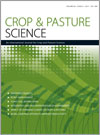Winter wheat genotypes can synergise with early establishment to deliver large increases in yield in southern Australia. The role that winter wheats have historically played in southern farming systems is reviewed, and opportunities for future synergies with management identified.

Crop and Pasture Science
Volume 68 Number 6 2017
CP17135In-field methods for rapid detection of frost damage in Australian dryland wheat during the reproductive and grain-filling phase
Frost damage causes significant economic losses to Australian dryland wheat. This research looks at remote sensing technologies including hyperspectral reflectance and active light fluorescence for detecting frost damage to wheat. Results indicate that non-destructive measurements may support detection and mapping of frost damage, allowing farmers to reduce losses through better tactical management around cutting the crop for hay.
CP17135 Abstract | CP17135 Full Text | CP17135PDF (479 KB) Open Access Article
CP17176Novel bacterial seed treatment protects wheat seedlings from insect damage
Microbial insecticides are a biological alternative for chemical seed treatments to target root feeding insects such as New Zealand grass grub. Treatment with Serratia entomophila gave similar yield increases to organophosphate and neonicotinoid treatments of wheat seeds for two out of six trials. Seed treatment with S. entomophila is an alternative method for grass grub control, however development of a commercial product requires effective scale-up of the production process.
CP17112Response of wheat to post-anthesis water stress, and the nature of gene action as revealed by combining ability analysis
A full diallel analysis of four wheat genotypes revealed variable responses of the studied traits when the parents and their hybrids are subjected to post-anthesis water stress. Combining ability analysis indicated that both additive and non-additive gene actions were involved in governing the inheritance of the studied traits, with predominance of non-additive gene action for most of the traits. Specificity of some parental genotypes as female parents in cross combination was also discovered.
CP17022Free radical scavenging activities can mitigate the effect of water stress in chickpea
Drought tolerance mechanism in chickpea (Cicer arietinum L.) needs to be better understood as terminal drought severely restricts its productivity. The influence of water deficit stress on antioxidative capacity due to scavenging of free radicals and the ability to maintain reduced cell state was investigated in two chickpea cultivars differing in rooting behaviour. ICC4958 (deep rooted) possessed better ability to combat water deficit induced oxidative stress relative to ILC3279 (shallow rooted). The results can improve our understanding about the role of antioxidative defense system in providing water stress tolerance in chickpea.
CP17158Detached-petiole inoculation method to evaluate Phytophthora root rot resistance in soybean plants
Phytophthora root rot is one of the most important soybean diseases and planting the resistance cultivars is the most effective method to control this disease. In this study, a detached-petiole inoculation method were established for identifying soybean resistance to P. sojae and this new inoculation technique is effective, reliable, non-destructive to the plant. It could be used for the largescale screening of soybean cultivars and segregant populations.
CP17032Effects of pasture base and species mix complexity on persistence and weed ingress in summer-dry dairy pastures
We tested the hypotheses that sowing a more drought tolerant pasture base, or increasing the diversity of the sown mix, could increase pasture persistence. Persistence, quantified by changes over time in basal and canopy cover of sown species, was greater in tall fescue- than perennial ryegrass-based swards and greater in the 4- and 8-species than in the 2-species mix, although weed ingress was similar in all pasture mixes. The effects of changing the pasture base and diversity on persistence were similar, indicating that both options could be used to improve pasture persistence
CP17137Growth during recovery evidences the waterlogging tolerance of forage grasses
Waterlogging is an important stress for pastures. Morpho-physiological and growth responses to 15-day waterlogging and 15-day recovery-period were evaluated on four grasses with alleged differential tolerance. Tolerance was apparent in Phalaris aquatica and Festuca arundinacea along both periods, while impact of waterlogging on growth reduction in the sensitive Dactilys glomerata and Bromus catharticus was only evident during recovery. It is essential to examine plant recovery in order to be conclusive about waterlogging tolerance.
CP17183Environmental factors affect seed germination and seedling emergence of invasive Centaurea balsamita
Centaurea balsamita is a problematic and invasive weed of agricultural fields in western Iran. Therefore, in this study the effect of different environmental factors on its seed germination and seedling emergence was examined. Results showed that C. balsamita has the potential to invade more areas and that this information would be beneficial in developing methods for its control.



